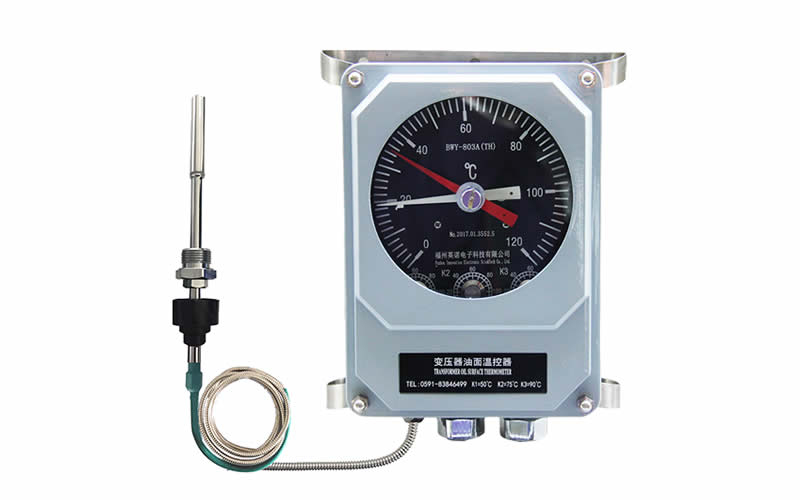Transformer oil temperature protection
Date: July 30, 2025 18:49:42
Transformer oil temperature protection is a "temperature control guardian" to prevent transformer damage due to abnormal temperature rise, and its core role is to intervene in overheating state in time by monitoring the top oil temperature of transformer to avoid accelerated aging of insulation or burning of windings. It is not only the "guardian" to protect the life of the equipment, but also the key line of defense to maintain the stable operation of the power grid. The following detailed analysis from the principle, composition, action logic and other aspects:

Why is oil temperature a "health barometer" for transformers?
When the transformer is running, the winding losses (copper losses) and core losses (iron losses) are converted into heat, which increases the temperature of the insulating oil. Under normal circumstances, the oil temperature is balanced by heat sink and environmental heat dissipation, but if the loss increases abnormally (such as winding short circuit) or heat dissipation is blocked (such as fan failure), the oil temperature will continue to rise:
- When the oil temperature exceeds80°C When the insulating oil oxidizes faster, the life will be shortened exponentially with the temperature increase (every 10 ℃, the oxidation rate is doubled);
- outweigh105°C When the mechanical strength of insulating paper (core material of winding insulation) begins to decline significantly, long-term operation may lead to insulation breakdown, triggering short-circuit faults.
Therefore, the essence of oil temperature protection is to "protect" the insulation system by controlling the upper temperature limit.
Core components of oil temperature protection and monitoring objects
The oil temperature protection system consists ofTemperature monitoring elements,signal processing unitrespond in singingexecuting agencyIt is composed of three parts, which work together to complete the process of "Temperature Measurement - Judgment - Action".
1. Key monitoring elements: temperature sensors
The sensor is the "eye" of the oil temperature protection and needs to be in direct contact with the top oil surface (most reflective of the overall oil temperature), the common types and characteristics are as follows:
| Sensor type | Working Principle | dominance | Applicable Scenarios |
| Pressure thermometer | The thermowell is filled with a volatile liquid (e.g., chloromethane), which expands/contracts when the temperature changes, transmitting the pressure through the capillary tube and actuating the pointer and electrical contacts. | Simple structure, vibration-resistant (no electronics), local display possible. | Small and medium-sized transformers (up to 10 MVA), outdoor distribution transformers. |
| Platinum resistance sensors(Pt100) | Using the characteristics of platinum resistance changes with temperature (100Ω at 0℃, resistance increases by 0.385Ω for every 1℃ rise in temperature), the resistance signal is transmitted to the thermostat via cable. | High measurement accuracy (±0.5°C) and remote data transmission. | Large-capacity transformers (35kV and above), substations requiring centralized monitoring. |
| Fiber Optic Sensors | The phase/intensity of an optical signal varies with temperature as it travels through an optical fiber, and is converted to a temperature value by a demodulation device. | Anti-electromagnetic interference (suitable for high-voltage environments), corrosion-resistant. | Extra-high voltage transformers (1000kV), special transformers with multiple oil gap structures. |
2. Signal processing and control: thermostats
The thermostat is the "brain" of the oil temperature protection, which receives the sensor signal, compares it with the preset threshold, and outputs the control command. Its core functions include:
- Real-time display of oil temperature (local LED or remote monitoring system);
- Set multi-level temperature thresholds (e.g., initiate cooling, alarm, trip);
- Records temperature profiles and action history (for easy fault tracing).
Three-stage action logic for oil temperature protection: from warning to shutdown
Oil temperature protection adopts the "stepped response" strategy, escalating the action step by step according to the degree of temperature rise, balancing equipment protection and power supply continuity, with the following specific thresholds (for example, for oil-immersed transformers):
| temperature range | trigger condition | protective action | Purpose and significance |
| Start-up cooling (typically 60~70°C) | The oil temperature reaches the set value (can be adjusted according to the ambient temperature, e.g. 60℃ in summer and 70℃ in winter). | Automatic activation of the cooling system: - Small transformers: Turn on the cooling fan; - Large transformers: start one set of oil pumps + fan, if the temperature continues to rise, then put in the backup cooler. |
Reducing the oil temperature by active heat dissipation to avoid further temperature increase is a "preventive intervention". |
| High temperature alarm (normally 85~95°C) | After the oil temperature exceeds the cooling start value, it continues to rise to the alarm threshold after 30~60 minutes. | Sound and light alarms are issued (e.g., control room alarm, monitoring system pop-up window), and the alarm time and oil temperature value are recorded at the same time. | Prompts the operator to check the cause of the abnormality (e.g., cooling system failure, excessive load), requiring manual intervention. |
| Emergency trip (normally 95~105°C) | The oil temperature exceeds the alarm value and rises sharply for a short period of time (e.g. 10°C within 5 minutes) or reaches the maximum permissible value. | Immediately disconnect the circuit breaker on both sides of the transformer, cut off the power supply, and at the same time linkage issued "oil temperature is too high trip" signal. | Avoid high oil temperatures leading to vaporization of insulating oil and breakdown of insulating paper, which belongs to the "last line of defense". |
classifier for sums of money: Threshold settings vary slightly from manufacturer to manufacturer, e.g. for transformers with forced oil circulation cooling, the tripping temperature may be relaxed to 110°C (due to more efficient heat dissipation), refer to the equipment nameplate for details.
Synergistic relationship between oil temperature protection and other temperature protection
Transformer temperature protection system, oil temperature protection andWinding temperature protectionThere is both a division of labor and collaboration, and the distinction between the two and the logic of linkage needs to be clarified:
| comparison dimension | Oil temperature protection | Winding temperature protection | cooperative logic |
| Monitoring Objects | Average temperature of the top insulating oil | Hot spot temperature inside the winding (10~20°C higher than the oil temperature) | During normal operation, oil temperature protection is predominant (reflecting the overall condition); In case of short-circuit fault, the temperature of the winding rises sharply, which triggers the tripping of the winding protection in priority. |
| Measurement method | Direct contact with oil level (sensor on top of tank) | Indirect calculation (load current measured by current transformer, combined with oil temperature to derive hot spot temperature) | If the oil temperature protection does not operate but the winding temperature exceeds the upper limit, the system will determine that it is "local overheating" and force the start of cooling or tripping. |
| Protection Priority | Secondary (slower to reflect, suitable for chronic overheating) | Primary (fast response for sudden overheating) | Either of the two will trigger a shutdown if the tripping condition is reached, creating a "double insurance". |
Common faults and troubleshooting of oil temperature protection
Malfunction or failure of the oil temperature protection will directly threaten the safety of the equipment, need to focus on the following issues:
-
False Alarm / False Trip
- Causes: Loose sensor wiring (abnormal resistance signal), wrong thermostat setting value, poor heat dissipation due to dust accumulation in the radiator (falsely high temperature);
- Troubleshooting: recalibrate sensor, check thermostat parameters, clean radiator fins.
-
Inoperative (temperature exceeded but not responding)
- Causes: Damaged sensors (e.g., broken platinum resistors), actuator failures (e.g., burnt fan motors, jammed contactors), blown control circuit fuses;
- Troubleshooting: Use a multimeter to check the sensor resistance (Pt100 should be 100Ω at 0℃), manually test whether the cooling system is running, and check whether the control circuit is on or off.
-
Temperature display deviation
- Causes: aging of the sensor (loss of accuracy), ambient temperature interference (e.g. direct sunlight on the fuel tank leading to localized high temperature measurement);
- Treatment: Send the measurement organization to calibrate the sensor regularly (every 1~2 years), and install sunshade on the outdoor transformer.
Routine Maintenance and Optimization Suggestions
-
periodic calibration
- Perform annual simulation tests of the thermostat: heat the sensor with a thermostatic bath to verify that the temperature thresholds for cooling start, alarms, and trips are accurate;
- Check sensor cable insulation every 2 years (to prevent short circuits due to oil corrosion).
-
runtime optimization
- Adjust the cooling start-up temperature according to the season (e.g. increase to 70°C in winter to reduce unnecessary fan operation and save energy);
- Record the oil temperature - load curve (such as the same load under the oil temperature increases year by year, may indicate that the core silicon steel sheet aging, need to be overhauled in advance).
-
environmental adaptation
- Outdoor transformers need to ensure that the radiators are well ventilated (no weeds or debris blocking the surrounding area);
- High-temperature areas (such as the southern summer) can be installed with a spray cooling device, and oil temperature protection linkage (oil temperature over 75 ℃ automatic spray).
summarize
Oil temperature protection is the "basic line of defense" for transformer temperature control, realizing the hierarchical protection of "cooling regulation - abnormality warning - emergency shutdown" by monitoring the trend of top oil temperature. Its core value lies in balancing equipment safety and power supply reliability, not only to avoid over-protection leading to frequent shutdowns, but also "decisive action" before the dangerous threshold. In practice, it is necessary to pay attention to the synergy with the winding temperature protection, regular maintenance of sensors and actuators to ensure an effective response to both chronic overheating (e.g., excessive loads) and sudden failures (e.g., cooling failure), and ultimately to extend the service life of the transformer.













